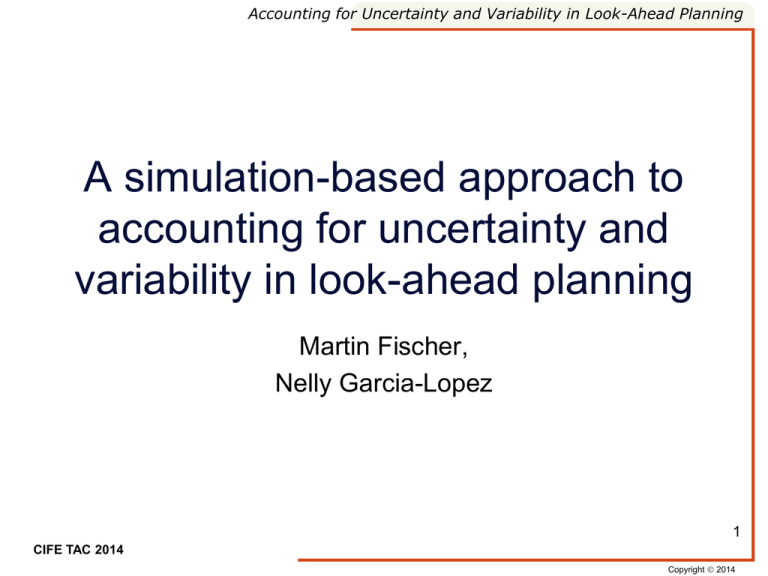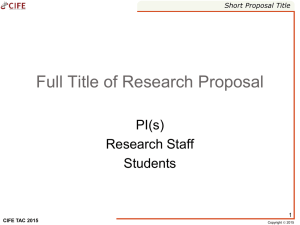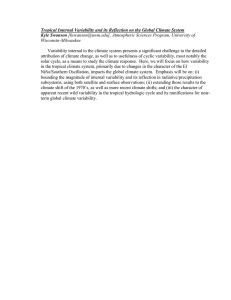A simulation-based approach to accounting for uncertainty and variability in look-ahead planning
advertisement

Accounting for Uncertainty and Variability in Look-Ahead Planning A simulation-based approach to accounting for uncertainty and variability in look-ahead planning Martin Fischer, Nelly Garcia-Lopez 1 CIFE TAC 2014 Copyright 2014 Accounting for Uncertainty and Variability in Look-Ahead Planning The big idea We propose to develop a Simulation-based lookahead planning method that considers the most frequent sources of variability formally to combine the knowledge of construction managers with a more formal method. Activity outcome metrics Uncertainty + Variability Construction Operations Production Management Strategy Dependent variables Chain outcome metrics Independent variables 2 CIFE TAC 2014 Copyright 2014 Accounting for Uncertainty and Variability in Look-Ahead Planning Motivating Problem Uncertainty affects activities in a construction site Uncertainty: • Labor: • Availability, skill • Tools & Equipment: • Availability, working • Information/plans • Updated, clarity • Materials: • Availability, quality Tie rebar activity • Previous work: • Completed, quality • External: • Weather 3 CIFE TAC 2014 Copyright 2014 Accounting for Uncertainty and Variability in Look-Ahead Planning Motivating Problem Uncertainty can lead to variability in activity execution Uncertainty: • Labor: • Availability, skill • Tools & Equipment: • Availability, working • Information/plans • Updated, clarity • Materials: • Availability, quality Tie rebar activity • Previous work: • Completed, quality • External: Variability in execution: • Productivity rates • Activity duration • Activity cost • Quality • Rework • Safety • Weather 4 CIFE TAC 2014 Copyright 2014 Accounting for Uncertainty and Variability in Look-Ahead Planning Motivating Problem Why is this an issue? • Construction activities are tightly interrelated • Downstream activities are affected by variability in upstream activities Tie Rebar Variability Pour Concrete Variability Finish Concrete Variability Managers need to design production systems to minimize the effect of uncertainty and variability while meeting project objectives (cost, schedule, etc.). 5 CIFE TAC 2014 Copyright 2014 Accounting for Uncertainty and Variability in Look-Ahead Planning Motivating Problem Production Management Strategies to minimize impact of variability 1. Implement buffers: Tradeoff between cost and duration. Impact on project objective Buffer Capacity Inventory Time CIFE TAC 2014 Cost Duration 2. Implement variability reduction strategies: • E.g. Standardization, last planner, takt time. Issues: • Require coordination among various players. • Difficult to implement a short term. 6 Copyright 2014 Accounting for Uncertainty and Variability in Look-Ahead Planning Motivating Problem Alignment between production strategy and objectives Project Superintendent Electrical Subcontractor Policy Start rough-in as soon as possible Start rough-in once whole floor has been framed Objective Open up work for other activities Keep crew utilization high Capacity buffer Time buffer Production strategy What production strategy is better? 7 CIFE TAC 2014 Copyright 2014 Accounting for Uncertainty and Variability in Look-Ahead Planning Intuition • Develop a method to simulate the effects of uncertainty and variability and evaluate how they impact the project at an activity level and a chain level. • Assess the effect of implementing different production management strategies on the metrics at the activity level and the chain level. 8 CIFE TAC 2014 Copyright 2014 Accounting for Uncertainty and Variability in Look-Ahead Planning Intuition Model Conceptualization Activity outcome metrics Uncertainty + Variability Construction Operations Production Management Strategy Dependent variables Chain outcome metrics Independent variables 9 CIFE TAC 2014 Copyright 2014 Accounting for Uncertainty and Variability in Look-Ahead Planning Intuition Example: Wall chain of activities Productivity rate [LF/day] Finishing Crew Rocking Crew 80 80 Traditional planning: CIFE TAC 2014 Framing Crew 80 Assumptions: • No variability • No loss in productivity Lags between activities are defined based on intuition and past experience. 10 Copyright 2014 Accounting for Uncertainty and Variability in Look-Ahead Planning Intuition Example: Simulation of wall chain of activities End of DAY 1 Productivity rate [LF/day] WIP [LF] Pot. Output Act. Output Lost Prod Cum. Lost Prod Finishing Crew 50-110 Rocking Crew Framing Crew 50-110 50-110 - 75 - - - - 75 11 CIFE TAC 2014 Copyright 2014 Accounting for Uncertainty and Variability in Look-Ahead Planning Intuition Example: Simulation of wall chain of activities End of DAY 2 Productivity rate [LF/day] WIP [LF] Pot. Output Act. Output Lost Prod Cum. Lost Prod Finishing Crew 50-110 Rocking Crew Framing Crew 50-110 50-110 - 56 - 100 100 0 - 0 81 12 CIFE TAC 2014 Copyright 2014 Accounting for Uncertainty and Variability in Look-Ahead Planning Intuition Example: Simulation of wall chain of activities End of DAY 3 Productivity rate [LF/day] WIP [LF] Pot. Output Act. Output Lost Prod Cum. Lost Prod Finishing Crew 50-110 Rocking Crew Framing Crew 50-110 50-110 91 20 105 105 0 96 96 0 0 0 60 13 CIFE TAC 2014 Copyright 2014 Accounting for Uncertainty and Variability in Look-Ahead Planning Intuition Example: Simulation of wall chain of activities End of DAY 4 Productivity rate [LF/day] WIP [LF] Pot. Output Act. Output Lost Prod Cum. Lost Prod Finishing Crew 50-110 Rocking Crew Framing Crew 50-110 50-110 57 0 109 109 0 106 75 31 0 31 55 14 CIFE TAC 2014 Copyright 2014 Accounting for Uncertainty and Variability in Look-Ahead Planning Intuition Example: Simulation of wall chain of activities End of DAY 5 Productivity rate [LF/day] WIP [LF] Pot. Output Act. Output Lost Prod Cum. Lost Prod Finishing Crew 50-110 Rocking Crew Framing Crew 50-110 50-110 7 28 102 102 0 52 52 0 0 31 80 15 CIFE TAC 2014 Copyright 2014 Accounting for Uncertainty and Variability in Look-Ahead Planning Intuition Example: Simulation of wall chain of activities End of DAY 6 Productivity rate [LF/day] WIP [LF] Pot. Output Act. Output Lost Prod Cum. Lost Prod Finishing Crew 50-110 Rocking Crew Framing Crew 50-110 50-110 0 26 104 85 19 78 78 0 19 31 76 16 CIFE TAC 2014 Copyright 2014 Accounting for Uncertainty and Variability in Look-Ahead Planning Intuition Example: Simulation of wall chain of activities End of DAY 10 Productivity rate [LF/day] WIP [LF] Pot. Output Act. Output Lost Prod Cum. Lost Prod Finishing Crew 50-110 Rocking Crew Framing Crew 50-110 50-110 0 0 69 52 17 72 52 20 81 143 52 17 CIFE TAC 2014 Copyright 2014 Accounting for Uncertainty and Variability in Look-Ahead Planning Intuition Example: Simulation of wall chain of activities End of DAY 20 Productivity rate [LF/day] WIP [LF] Pot. Output Act. Output Lost Prod Cum. Lost Prod Finishing Crew 50-110 Rocking Crew Framing Crew 50-110 50-110 0 22 110 110 0 110 110 0 154 184 59 18 CIFE TAC 2014 Copyright 2014 Accounting for Uncertainty and Variability in Look-Ahead Planning Intuition Example: Simulation of wall chain of activities End of DAY 30 Productivity rate [LF/day] WIP [LF] Pot. Output Act. Output Lost Prod Cum. Lost Prod Finishing Crew 50-110 Rocking Crew Framing Crew 50-110 50-110 53 107 79 79 0 110 110 0 167 212 109 19 CIFE TAC 2014 Copyright 2014 Accounting for Uncertainty and Variability in Look-Ahead Planning Intuition Analysis of WIP Buffer sizing vs. Production metrics Effect of WIP buffer on production metrics Average results after 1,000 runs 140 120 Linear Feet 100 80 Rocker total avg. lost production Finisher total avg. lost production 60 Avg. Finish Date 40 20 0 20 40 60 80 WIP Buffer 100 120 200 20 CIFE TAC 2014 Copyright 2014 Accounting for Uncertainty and Variability in Look-Ahead Planning Points of Departure 1. Uncertainty and Variability • Environmental uncertainty (Downey et al. 1975) • Project uncertainty management (Ward & Chapman 2003) • Lean Construction (Ballard & Howell 1998) 2. Workflow 3. Simulation 4. VDC • “Flow View” of Production (Koskela 1992) • “Parades of Trades” (Tommelein et al. 1998) • Model interactions and random events (Law 2014) • Worklow modeling (Tommelein 1998) • WIP buffers (Gonzalez et al. 2008, 2011) • Multidisciplinary performance models (Kunz & Fischer 2009) • 4D Modeling (Aalami 1998, McKinney & Fischer 1998) • IT in construction (Fischer & Kunz 2004) 21 CIFE TAC 2014 Copyright 2014 Accounting for Uncertainty and Variability in Look-Ahead Planning Gaps Identified 1. Current approaches do not capture effects of local optimization by subcontractors, which have been observed in practice. 2. Lack of understanding about how sources of uncertainty and variability affect construction operations and how they can be formally introduced into the planning process. 22 CIFE TAC 2014 Copyright 2014 Accounting for Uncertainty and Variability in Look-Ahead Planning Research Method Research Questions: 1. What sources of uncertainty affect different construction activities? 2. What production management strategies are implemented by subcontractors and GCs to cope with the different types of uncertainty and variability identified in RQ1? 3. How much more predictive power is gained by incorporating the sources of uncertainty and variability identified in RQ1 and the production management strategies identified in RQ2 in a computational model of the construction chain of activities? 4. What metrics would help managers evaluate the effect of implementing different production strategies, such as buffers or variability reduction, on the construction operations? 23 CIFE TAC 2014 Copyright 2014 Accounting for Uncertainty and Variability in Look-Ahead Planning Research Method Research Design: Part 1: Case studies + Project Data Analysis • Understand the sources of uncertainty and variability that affect construction chains of activities. • 3-5 case studies involving managers, subcontractor and workers. • Data analysis on projects tracking Percent Plan Complete (PPC) and reasons for non-completion to characterize variability sources. Part 2: Simulation model • Build simulation model: • Chains of construction activities. • Uncertainty and variability in activities. • Activity outcome metrics: activity cost (versus plan), activity man-hours (versus plan), idle time, activity duration (versus plan). • Chain of activity outcome metrics: operation cost (versus plan), total operation man-hours (versus plan), total idle time, total duration (versus plan). • Verify and validate simulation model with industry experts. 24 CIFE TAC 2014 Copyright 2014 Accounting for Uncertainty and Variability in Look-Ahead Planning Relationship to CIFE Goals • Improve construction operations through the innovative integration of: – Computer simulation – Scheduling and production planning – 4D visualization 25 CIFE TAC 2014 Copyright 2014 Accounting for Uncertainty and Variability in Look-Ahead Planning Industry Involvement Part 1 • Cary out 3-5 case studies of chains of activities of CIFE member projects. • Learn about the system to build an accurate model. • Understand sources of uncertainty and variability. • Data from CIFE member projects tracking PPC and reasons for noncompletion. • Characterize the probability of occurrence of different sources of variation. Part 2 • Reach out to CIFE members to review simulation model. • Conformance of model to own experience. • Feedback and improvements to the model. 26 CIFE TAC 2014 Copyright 2014 Accounting for Uncertainty and Variability in Look-Ahead Planning Research Plan Sept-Dec 2014 • Build basic simulation model • Milestone: Simulation model Jan-March 2015 • Case studies of chains of activities • Milestone: Case study reports March-Jun 2015 Jul-Sept 2015 • Model uncertainty and variability • Verify and calibrate simulation model • Milestone: Final CIFE Seed Report 27 CIFE TAC 2014 Copyright 2014 Accounting for Uncertainty and Variability in Look-Ahead Planning Risks and Mitigation Inability to validate simulation model • Overlap modeling and Part 1 to anticipate missing elements/data Sources of • Focus on identifying a few key drivers uncertainty/variability cannot instead of an exhaustive list be classified and add to much complexity to model Subcontractors unwillingness to share local optimization strategies • Approach subcontractors directly rather than in a project • Triangulate with other sources of data such as observation and interviews with other subcontractors 28 CIFE TAC 2014 Copyright 2014 Accounting for Uncertainty and Variability in Look-Ahead Planning Expected Contributions 1. A methodology for identifying, characterizing, and classifying different sources of uncertainty and variability related to construction activities. 2. A simulation model that enables mangers to virtually experiment with different production management strategies and their effect on the system metrics. This model takes into account the uncertainty and variability related to construction activities. 29 CIFE TAC 2014 Copyright 2014 Accounting for Uncertainty and Variability in Look-Ahead Planning Next Steps The model presented in this research proposal can be extended in two main ways. 1. Incorporate simulation model with 4D model. 2. Extend the simulation model to handle more complex interactions between chains of activities. 30 CIFE TAC 2014 Copyright 2014 Accounting for Uncertainty and Variability in Look-Ahead Planning Thank you! Questions? Suggestions? 31 CIFE TAC 2014 Copyright 2014 Accounting for Uncertainty and Variability in Look-Ahead Planning Motivating Problem • How do projects account for variability today? Initial Plan Assumptions about downstream activities: 1 2 Start dates are “pushed”, activities can start on the new date. Lags between activities are sized to account for variability in predecessor activity Updated Plan Start of Electrical rough-in delayed by 1 day 32 CIFE TAC 2014 Copyright 2014




